

AP® English Literature
The ultimate guide to “great expectations” for the ap® english literature free response questions.
- The Albert Team
- Last Updated On: March 1, 2022
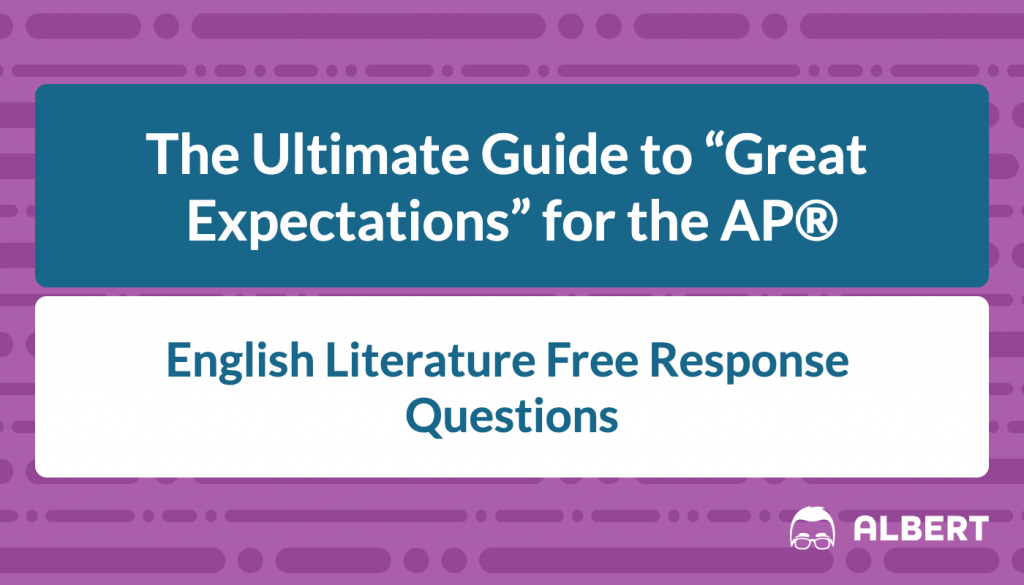
The 2017 AP® English Literature Free Response Questions focus on varying themes and are each structured differently. Here we discuss the third FRQ prompt which allows you to choose a particular work of literature as the focus of your essay.
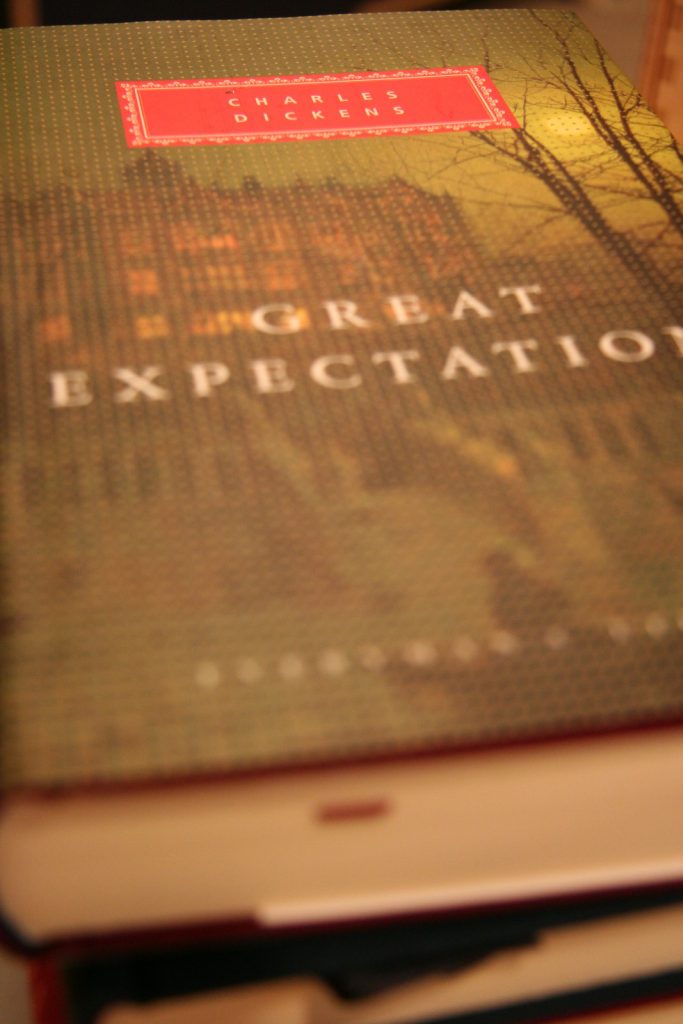
Great Expectations by Charles Dickens is a well-known classic novel. Herein we will discuss how to determine if the given prompt is appropriate for this particular literary work and give you an idea of what to review before your exam.
Great Expectations Themes for AP® English Literature
To choose a literary work to answer your prompt, it’s important to examine the themes which are outlined in the assigned essay. If the theme is not relevant or well established in a work, you will do well to choose another title to examine. The following are the main themes which you may discuss in your Great Expectations AP® English Lit Essay. Ambition and Self Improvement are the main themes of this classic story. Dickens teaches Pip lessons about the importance of loyalty, affection and social conscience by allowing his pursuit of the opposite. Throughout the story, his pursuit of wealth and a higher social class is punctuated by failures and a greater understanding of life’s most important factors. Social Classes are another prevalent theme explored throughout the book. The characters and story are based in the post-Industrial Revolution Victorian England. This chosen backdrop influences Dickens’ portrayal of everyone from the lowest caste to the wealthiest of families. He connects wealth with work and improvement of one’s self. This is why even the richest characters portrayed have achieved station based on success in business. Innocence and Guilt are intertwined themes represented throughout the book by convicts and lawyers alike. Dickens allows Pip to learn that often we must trust our instincts about people and not judge them based on society’s standards.
How to use Great Expectations for the 2017 AP® English Literature Free Response Questions
Great Expectations is a well-known literary work, with which you should be familiar. It may well be a viable choice for the AP® English Lit free response question. However, that is dependent on the question. Each year the 3rd FRQ is different, and the CollegeBoard supplies a list of suggested books to reference for your essay. The absence of a book from the list does not disqualify it from use, that being said; it’s important to know how to choose which book to use for the given analysis.
In preparation for your exam, it’s a good idea to read previous years’ free response questions posted on CollegeBoard. The following review is for the 2016 FRQ prompt.
2016 FRQ 3: Many works of literature contain a character who intentionally deceives others. The character’s dishonesty may be intended to either help or hurt. Such a character, for example, may choose to mislead others for personal safety, to spare someone’s feelings, or to carry out a crime.
Choose a novel or play in which a character deceives others. Then, in a well-written essay, analyze the motives for that character’s deception and discuss how the deception contributes to the meaning of the work as a whole.
While Great Expectations is not on the suggested list for this prompt, you may choose to use it. The theme of deception is represented by various characters in the story. However, the most prevalent one is probably Abel Magwitch, the convict. A thesis for this essay may look something like the following . In Great Expectations, the character of Abel Magwitch used deliberate anonymity to perpetrate deception on Pip to help him improve his station in life.
To support this thesis, you may point out that Magwitch is the only character who uses his earnings in what seems to be a selfless way. He is also the only truly self-made man, written by Dickens, in this story. Both of these characteristics are essential to the reasoning for his deception. Magwitch wanted Pip to become a gentleman and live a proper, wealthy life. He has to work hard to gain the money to drive this transformation while in Australia.
He could have made himself known from the start, but he thinks Pip is more likely to achieve these goals, without that knowledge. The following quote, from Chapter 2, shows that Magwitch sent all his gains for Pip.
“As I give’ you to understand just now, I’m famous for it. It was the money left me, and the gains of the first few year wot I sent home to Mr. Jaggers—all for you—when he first came after you, agreeable to my letter.”
Magwitch was born poor and could have easily used his fortune to improve his own life, as illustrated in the following quote from Chapter 42.
“I first become aware of myself, down in Essex, a thieving turnips for my living. Summun had run away from me—a man—a tinker—and he’d took the fire with him, and left me very cold.”
However, he remembered the help Pip had given him, years earlier, and dedicated himself to creating a gentleman. Later it becomes apparent that Magwitch feels he owns Pip for the support he bestowed upon him. This is outlined in the following quote from Chapter 39.
“He was a convict, a few year ago, and is an ignorant common fellow now, for all he’s lucky,’ what do I say? I say to myself, ‘If I ain’t a gentleman, nor yet ain’t got no learning, I’m the owner of such. All on you owns stock and land; which on you owns a brought-up London gentleman?”
To examine another possible use for Great Expectations on your 2017 English Lit Exam we will take a look at another prompt.
2015 FRQ 3 : In literary works, cruelty often functions as a crucial motivation or a major social or political factor. Select a novel, play, or epic poem in which acts of cruelty are important to the theme. Then write a well-developed essay analyzing how cruelty functions in the work as a whole and what the cruelty reveals about the perpetrator and/or victim.
Great Expectations was on the provided list for this year’s prompt, with good reason. Cruelty is an underlying theme throughout the story. A possible thesis is as follows. In Great Expectations, the theme of cruelty is represented through both physical and psychological means of individuals and society. To elaborate on this thesis and explain what it reveals about the perpetrator and/or victim, you will need to choose your examples and expand upon them.
You can choose from Pip being abused by his sister and Miss Havisham. The abuse he undergoes at the hands of Estella and conversely the abuse suffered by Estella to make her into a weapon of destruction. Further options include the cruel deception played on Miss Havisham which resulted in her sick mind and victimization of others or the way society cruelly leaves the poor to fend for themselves and then punishes them for that necessity, as is the case with Magwitch’s childhood and later life.
For example, Pip undergoes cruelty at the heavy hand of his sister and the mental turmoil supplied by Miss Havisham. The way that Pip reacts to his abuse is indicative of a boy who doesn’t think he is worthy of better treatment. He not only undergoes physical harm from Mrs. Joe but also harms himself as a punishment for his weakness. Furthermore, when faced with disdain and rejection from Estella, thanks to the plans of Miss Havisham, he reacts by loving her more. Evidence for these statements can be found in the following quotes from chapters 8, 29, 29, 39, and 44 respectively.
“ My sister’s bringing up had made me sensitive. In the little world in which children have their existence whosoever brings them up, there’s nothing so finely perceived and so finely felt, as injustice. It may be only small injustice that the child can be exposed to; but the child is small, and its world is small, and its rocking-horse stands as many hands high, according to scale, as a big-boned Irish hunter.” -Pip
“The unqualified truth is, that when I loved Estella with the love of a man, I loved her simply because I found her irresistible. Once for all; I knew to my sorrow, often and often, if not always, that I loved her against reason, against promise, against peace, against hope, against happiness, against all discouragement that could be. Once for all; I loved her nonetheless because I knew it, and it had no more influence in restraining me, than if I had devoutly believed her to be human perfection.” -Pip
“I have not bestowed my tenderness anywhere. I have never had any such thing.” -Estella “Miss Havisham’s intentions towards me, all a mere dream; Estella not designed for me; I only suffered in Satis House as a convenience, a sting for the greedy relations, a model with a mechanical heart to practise on when no other practice was at hand; those were the first smarts I had.” -Pip
“It would have been cruel in Miss Havisham, horribly cruel, to practice on the susceptibility of a poor boy, and to torture me through all these years with a vain hope and an idle pursuit, if she had reflected on the gravity of what she did. But I think she did not. I think that in the endurance of her own trial, she forgot mine, Estella.” – Pip
Classic literary works always have many themes, allowing for their use in a variety of prompt types. Let’s examine another free response question from a previous year. Again, Great Expectations was not on the suggested list. However, reading the theme and question, we can determine it is a viable choice.
2014 FRQ 3 : It has often been said that what we value can be determined by what we sacrifice. Consider how this statement applies to a character from a novel or play. Select a character that has deliberately sacrificed, surrendered, or forfeited something in a way that highlights that character’s values. Then write a well-organized essay in which you analyze how the particular sacrifice illuminates the character’s values and provides a deeper understanding of the meaning of the work as a whole.
A thesis which could be supported for this prompt is as follows. In Great Expectations, the sacrifice of Joe to stay with Mrs. Joe, for the good of Pip, shows that he values the well-being of the boy above his own and informs the development of Pip’s own values.
To support this thesis, you could expound on the abuse Joe underwent from Mrs. Joe and the fact that he was always there for Pip, even when Pip was not appreciative. Furthermore, Joe’s love for Pip is intertwined with Dickens’ message to not judge people by social class or appearance, rather by who they are. The following quote, from Chapter 7, illustrates that Joe wanted to take Pip in after the death of his parents.
“I said to her, ‘And bring the poor little child. God bless the poor little child,’ I said to your sister, ‘there’s room for him at the forge!'” -Joe
In chapter 57, we see Joe again comes to rescue Pip.
“ I opened my eyes in the night, and I saw, in the great chair at the bedside, Joe. I opened my eyes in the day, and, sitting on the window-seat, smoking his pipe in the shaded open window, still I saw Joe. I asked for cooling drink, and the dear hand that gave it me was Joe’s. I sank back on my pillow after drinking, and the face that looked so hopefully and tenderly upon me was the face of Joe.”
“For the tenderness of Joe was so beautifully proportioned to my need, that I was like a child in his hands. He would sit and talk to me in the old confidence, and with the old simplicity, and in the old unassertive protecting way, so that I would half believe that all my life since the days of the old kitchen was one of the mental troubles of the fever that was gone.”
In conclusion, Great Expectations has many themes you may find helpful for the last Free Response Question on the AP® English Literature Exam. When reading the prompt and deciding on what literary work to use for your essay, remember to choose a subject where the theme outlined in the given instructions is prevalent.
In the case of Great Expectations ambition, self-improvement, social classes, innocence, and guilt are a few of the more prominent themes discussed. However, as we saw with the 2016 prompt example, this story has many underlying themes which you may examine for your Great Expectations AP® English Lit Essay.
For more help preparing for your AP® English Literature exam we suggest you read The Ultimate Guide to 2015 AP® English Literature FRQs . And, for writing advice for the AP® English Lit free response questions, Albert.io’s AP® English Literature section has practice free response sections with sample responses and rubrics.
Looking for AP® English Literature practice?
Kickstart your AP® English Literature prep with Albert. Start your AP® exam prep today .
Interested in a school license?
Popular posts.

AP® Score Calculators
Simulate how different MCQ and FRQ scores translate into AP® scores

AP® Review Guides
The ultimate review guides for AP® subjects to help you plan and structure your prep.

Core Subject Review Guides
Review the most important topics in Physics and Algebra 1 .

SAT® Score Calculator
See how scores on each section impacts your overall SAT® score

ACT® Score Calculator
See how scores on each section impacts your overall ACT® score

Grammar Review Hub
Comprehensive review of grammar skills

AP® Posters
Download updated posters summarizing the main topics and structure for each AP® exam.
Interested in a school license?

Bring Albert to your school and empower all teachers with the world's best question bank for: ➜ SAT® & ACT® ➜ AP® ➜ ELA, Math, Science, & Social Studies aligned to state standards ➜ State assessments Options for teachers, schools, and districts.
AP English Literature Practice Exams
Be sure to work through some of these AP English Literature practice exams. There are hundreds of challenging practice questions to try. Perfect for your test prep and review.
Official Practice Exam
Ap literature multiple choice, mymaxscore practice exam, albert ap english literature, official sample questions, varsity tutors, flashcard terms test.
AP English Literature | Practice Exams | Free Response | Vocab | Study Guides
Find what you need to study
AP Lit Prose Analysis: Practice Prompt Samples & Feedback
9 min read • january 2, 2021
Candace Moore
Practicing Prose Analysis is a great way to prep for the AP exam! Review practice writing samples and corresponding feedback from Fiveable teacher Candace Moore.
The Practice Prompt
Notes from the teacher.
While reading, consider the following questions:
- What is the author’s language doing ?
- What choices has the author made in her language?
- What is the meaning/impact of those choices?
As if you were writing a whole essay, write a thesis that establishes
1) the relationship Petry establishes between Lutie Johnson and the setting,
2) which figurative language devices Petry employed to establish the relationship, and
3) any complexity you identified in that relationship. Start a new paragraph that analyzes one pattern of figurative language and its role in the relationship. You should have at least two pieces of evidence and at least three sentences of commentary making the connection between the language and the claim from your thesis.
Replay: Prose Analysis Thesis and Introduction
Read the selection carefully and then write an essay analyzing how Petry establishes Lutie Johnson’s relationship to the urban setting through the use of literary devices.
Passage and Prompt
Writing Samples and Feedback
Student sample 1.
In The Street , by Ann Petry, the author establishes a victim and attacker relationship between Johnson and the urban setting. She uses personification, metaphor, and imagery of the wind to convey their relationship. Although the setting is portrayed as very violent, Petry also showcases its annoying characteristics to further add to their relationship.
The passage starts off with introducing the wind as it " rattled the tops of garbage cans and “ sucked window shades out ”. Immediately, it’s described as a violent figure that gives off an aggressive and depressing atmosphere. It purposely bothers people, going as far as driving them out the streets. It meticulously bothers Lutie Johnson as she shivers when “ the cold fingers of the wind touched the back of her neck, and explored the sides of her head. ”: making her feel uncomfortable and powerless.
Teacher feedback:
You have a thesis that establishes a line of reasoning, and names the relationship between Lutie and the setting, which is great! So that earns the point. My push for you would be to get all of that into one sentence, because that would cut down on the repetition, and strengthen your writing style. 1/1: Thesis
Your paragraph uses well-selected evidence, but as a reader, I’m not convinced that you know what part of your argument you’re proving in this paragraph, or how your line of reasoning is supported. The first three sentences are connected by the violence/aggression, but then you shift to a different aspect of the relationship in the second half without a clear link between. Ev&Comm: 2/4
Student Sample 2
In The Street, by Ann Petry, she establishes a negative relationship between Lutie Johnson and the urban setting. She uses the literary devices, personification and metaphor to show how the wind is impacting the people in the city. Petry also displays how the people in the urban area felt with the wind to express the negative relationship they have with the wind.
The way that the wind is expressed in the passage is as it were a human and has human features. An example of the wind having a human feature would be when the wind “did everything it could to discourage the people walking along the street.” One can notice that the wind ruined a person’s spirit while they are strolling through the streets. "And then the wind grabbed their hats, pried their scarves from around their necks, stuck its fingers inside their coat collars, blew their coats away from their bodies. " Petry used personification in that sentence to make it seem as though the wind has hands by saying that it grabbed hats and stuck its fingers in their coat collars to portray that the wind felt very eerie.
Your thesis establishes a relationship (negative), and names the devices that you will use in your analysis. However, your thesis does not establish a strong line of reasoning because you don’t make a whole argument when you say “how the people … felt” and “how the wind is impacting” instead of giving your interpretation (e.g. the people felt like victims, or the wind assaults them). 1/1
Your paragraph does clearly interpret the personification in the passage, and uses evidence that shows how Petry gives human qualities to the wind. However, you did not go the next step to analyze the relationship through the personification thoroughly. Try to spend more of your paragraph connecting the device to your argument, as well as clarifying the connection between the evidence points in your paragraph. 2/4
Student Sample 3
In The Street by Ann Petry, a negative relationship was established between the character Lutie Johnson and the urban setting in the story. The author uses diction, personification, and imagery to portray how the wind and Lutie have a negative relationship.
The word choice of Petry clearly establishes a negative relationship between Lutie and the wind by using words like “discourage,” “entangling,” “cold,” and “shivered.” All of these words hold negative connotation and create a feeling of invasiveness and being attacked. When the wind lifted Lutie’s hair and she “shivered as the cold fingers of the wind touched the back of her neck,” the audience can clearly see that the wind is not creating a pleasant sensation for Lutie. If the author were to use plain diction like “Lutie felt cold when the wind toughed her neck,” there would be no emotion and nor establishment of a strong relationship. The audience would have just known that the wind was cold.
Your thesis establishes your argument about a negative relationship and names the devices you will use. 1/1
The first two sentences of your paragraph are very strong – you have a device supported by the evidence, and your commentary connects to the argument. However, the rest of the paragraph does not analyze the relationship; it only interprets the diction. If you explained the connotation of that line as clearly, you would have a strong commentary. 2/4
Student Sample 4
In The Street , Ann Petry portrays the abusive relationship between Johnson and the urban setting, through the usage of diction, personification, and imagery. The main culprit of this abuse is the natural wind, how it is violent and stops at nothing to bother the characters.
The passage begins with introducing the wind as it “rattled the tops of garbage cans” and “sucked window shades out”. Right off the bat, the characteristics of the wind is violent, a force that cannot be stopped. The wind is aggressive, purposely bothering the people, completely emptying the streets. The wind then begins abuses Johnson, making her shiver with “[its] cold fingers touch[ing] the back of her neck, and explor[ing] the sides of her head.” This removes any power that Johnson could of had, ending with the wind dominating over her.
You have a strong thesis in regards to its argument establishment – you have clearly interpreted the relationship. 1/1
Your evidence is well-selected, and your commentary tightly connected to the line of reasoning you established in your thesis. The last sentence is very strong. Organizationally, I would move the second sentence to the beginning of the paragraph as your assertion, creating a thread for the paragraph from the start that you can follow through the rest of the sentences. This makes your line of reasoning clearer and stronger, and more “sophisticated”. 3/4
Student Sample 5
In The Street , by Ann Petry, a tug of war dynamic relationship is established between Lutie Johnson and the urban setting and portrayed in a negative light. Through the use of personification, imagery, and diction the fight Johnson faces against the brutal wind is shown.
Petry uses personification throughout the passage to describe the wind as if it is a person. Things such as, “Each time she thought she had the sign in focus, the wind pushed it away from her” By doing this the audience sees the wind directly affecting Johnson and creating a fighting relationship between the two of them. As Johnson tries to read a sign the wind pushes it away as if it doesn’t want her to go. By making it seem like the wind is trying to directly fight Johnson it makes the fight more personal The wind even chills Johnson by touching the back of her neck with its “cold fingers”. The wind now seems even more human like, as if the wind is grabbing Johnson in an aggressive manner. The act of the wind touching her neck is meant to scare Johnson and hold her back even more for where she needs to go. Each time Johnson tugs away from the wind, the wind pulls even more to fight Johnson.
Your thesis is strong, and establishes the relationship as one with a “tug of war dynamic”. 1/1
Your first sentence of your body paragraph establishes personification as the device, but only defines personification instead of beginning your interpretation that will lead to analysis (e.g. … personification to show the wind as creating barriers for Lutie). Your analysis is clear and effective, however, in showing the relationship and how the personification creates it. 3/4
Student Sample 6
In The Street , by Ann Petry, the author establishes an obstructive relationship between Luti Johnson and the urban setting, particularly the wind. Petry employs the use of personification, imagery, and metaphor to express how Luti struggles against the wind.
The author used personification to describe the wind throughout this passage. This makes the effects of the wind seem deliberate and personal. When Luti is first introduces in the passage, the wind “lifted” her hair, exposing her neck. This action caused Luti to feel vulnerable and cold. Then, “the cold fingers of the wind touched the back of her neck, explored the sides of her head.” This statement makes it seem as if the wind is purposely violating Luti’s privacy and exposing her to the cold. By using personification to describe the wind, the author takes a natural element and turns it into a cruel, aggressive character. By giving the wind this “personality,” Petry is able to convey how destructive its actions are towards Luti.
Good thesis! You’ve given a very specific name to the relationship that establishes a line of reasoning. Having two sentences to establish these parts isn’t necessary, though. 1/1
I appreciate that you have an assertion that shows where the sentence is going. Again those first two sentences could be one: Throughout the passage, the author personifies the wind’s actions as deliberate and personal. The rest of the paragraph is strong, however, and connects clearly and effectively to your argument. Make sure that it connects clearly to the thesis, as well.
Student Sample 7
In The Street , by Ann Petry, the author uses personification in order to show the wind as a powerful figure. Through these literary devices, the audience can see the influence of the winds on the people of the town, creating the wind to seem like a relentless bully.
At the beginning of the story, the personification of the wind is established. The wind comes off as aggressive and ruthless by driving people into their homes. The wind’s motive is then revealed, creating a sense of motivation that drives the wind “It did everything it could to discourage the people walking along the street” By blinding people with dust and wrapping the newspaper around their feet, the wind is portraying doing what a human would do when they are being malicious and ruthless. When Lutie Johnson is introduced, the audience gains a sense of innocence in her character. So, when the wind “… blew her eyelashes away from her eyes so that her eyeballs were bathed in a rush of coldness…” , the wind is conceived as a bully. The audience can help to feel bad for what she has to endure. The wind continues to have this bully mentality when she tries to read the sign. However, the wind eventually lets her read the sign, allowing her to see it for an instant.
Strong thesis! “Relentless bully” shows you are clear on the relationship, as well as how you plan to analyze it through the personification. 1/1
You have very effective word choice in your analysis, which makes your writing and analysis fluid. The line of reasoning from your thesis is supported by your interpretation of the wind as malicious, ruthless, etc. However, your introduction of Lutie as a character with innocence is not as clearly connected or supported, and your last sentence seems to contradict the rest of the paragraph. 3/4

Stay Connected
© 2024 Fiveable Inc. All rights reserved.
AP® and SAT® are trademarks registered by the College Board, which is not affiliated with, and does not endorse this website.

Choose Your Test
Sat / act prep online guides and tips, expert's guide to the ap literature exam.
Advanced Placement (AP)

If you're planning to take the AP English Literature and Composition exam, you'll need to get familiar with what to expect on the test. Whether the 2023 test date of Wednesday, May 3, is near or far, I'm here to help you get serious about preparing for the exam.
In this guide, I'll go over the test's format and question types, how it's graded, best practices for preparation, and test-day tips. You'll be on your way to AP English Lit success in no time!
AP English Literature: Exam Format and Question Types
The AP Literature Exam is a three-hour exam that contains two sections in this order:
- An hour-long, 55-question multiple-choice section
- A two-hour, three-question free-response section
The exam tests your ability to analyze works and excerpts of literature and cogently communicate that analysis in essay form.
Read on for a breakdown of the two different sections and their question types.
Section I: Multiple Choice
The multiple-choice section, or Section I of the AP Literature exam, is 60 minutes long and has 55 questions. It counts for 45% of your overall exam grade .
You can expect to see five excerpts of prose and poetry. You will always get at least two prose passages (fiction or drama) and two poetry passages. In general, you will not be given the author, date, or title for these works, though occasionally the title of a poem will be given. Unusual words are also sometimes defined for you.
The date ranges of these works could fall from the 16th to the 21st century. Most works will be originally written in English, but you might occasionally see a passage in translation.
There are, generally speaking, eight kinds of questions you can expect to see on the AP English Literature and Composition exam. I'll break each of them down here and give you tips on how to identify and approach them.
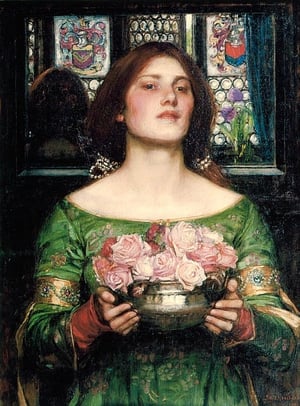
"Pretty flowers carried by ladies" is not one of the question types.
The 8 Multiple-Choice Question Types on the AP Literature Exam
Without further delay, here are the eight question types you can expect to see on the AP Lit exam. All questions are taken from the sample questions on the AP Course and Exam Description .

#1: Reading Comprehension
These questions test your ability to understand what the passage is saying on a pretty basic level . They don't require you to do a lot of interpretation—you just need to know what's going on.
You can identify this question type from words and phrases such as "according to," "mentioned," "asserting," and so on. You'll succeed on these questions as long as you carefully read the text . Note that you might have to go back and reread parts to make sure you understand what the passage is saying.

#2: Inference
These questions ask you to infer something—a character or narrator's opinion, an author's intention, etc.—based on what is said in the passage . It will be something that isn't stated directly or concretely but that you can assume based on what's clearly written in the passage. You can identify these questions from words such as "infer" and "imply."
The key to these questions is to not get tripped up by the fact that you are making an inference—there will be a best answer, and it will be the choice that is best supported by what is actually found in the passage .
In many ways, inference questions are like second-level reading comprehension questions: you need to know not just what a passage says, but also what it means.

#3: Identifying and Interpreting Figurative Language
These are questions for which you have to either identify what word or phrase is figurative language or provide the meaning of a figurative phrase . You can identify these as they will either explicitly mention figurative language (or a figurative device, such as a simile or metaphor ) or include a figurative phrase in the question itself.
The meaning of figurative phrases can normally be determined by that phrase's context in the passage—what is said around it? What is the phrase referring to?
Example 1: Identifying
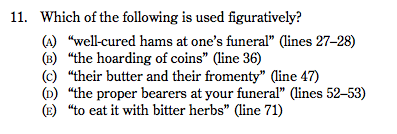
Example 2: Interpreting

#4: Literary Technique
These questions involve identifying why an author does what they do , from using a particular phrase to repeating certain words. Basically, what techniques is the author using to construct the passage/poem, and to what effect?
You can identify these questions by words/phrases such as "serves chiefly to," "effect," "evoke," and "in order to." A good way to approach these questions is to ask yourself: so what? Why did the author use these particular words or this particular structure?

#5: Character Analysis
These questions ask you to describe something about a character . You can spot them because they will refer directly to characters' attitudes, opinions, beliefs, or relationships with other characters .
This is, in many ways, a special kind of inference question , since you are inferring the broader personality of the character based on the evidence in a passage. Also, these crop up much more commonly for prose passages than they do for poetry ones.

#6: Overall Passage Questions
Some questions ask you to identify or describe something about the passage or poem as a whole : its purpose, tone, genre, etc. You can identify these by phrases such as "in the passage" and "as a whole."
To answer these questions, you need to think about the excerpt with a bird's-eye view . What is the overall picture created by all the tiny details?

#7: Structure
Some AP Lit questions will ask you about specific structural elements of the passage: a shift in tone, a digression, the specific form of a poem, etc . Often these questions will specify a part of the passage/poem and ask you to identify what that part is accomplishing.
Being able to identify and understand the significance of any shifts —structural, tonal, in genre, and so on—will be of key importance for these questions.

#8: Grammar/Nuts & Bolts
Very occasionally you will be asked a specific grammar question , such as what word an adjective is modifying. I'd also include in this category super-specific questions such as those that ask about the meter of a poem (e.g., iambic pentameter).
These questions are less about literary artistry and more about the fairly dry technique involved in having a fluent command of the English language .
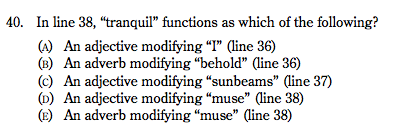
That covers the eight question types on the multiple-choice section. Now, let's take a look at the free-response section of the AP Literature exam.

Keep track of the nuts and bolts of grammar.
Section II: Free Response
The AP Literature Free Response section is two hours long and involves three free-response essay questions , so you'll have about 40 minutes per essay. That's not a lot of time considering this section of the test counts for 55% of your overall exam grade !
Note, though, that no one will prompt you to move from essay to essay, so you can theoretically divide up the time however you want. Just be sure to leave enough time for each essay! Skipping an essay, or running out of time so you have to rush through one, can really impact your final test score.
The first two essays are literary analysis essays of specific passages, with one poem and one prose excerpt. The final essay is an analysis of a given theme in a work selected by you , the student.
Essays 1 & 2: Literary Passage Analysis
For the first two essays, you'll be presented with an excerpt and directed to analyze the excerpt for a given theme, device, or development . One of the passages will be poetry, and one will be prose. You will be provided with the author of the work, the approximate date, and some orienting information (i.e., the plot context of an excerpt from a novel).
Below are some sample questions from the 2022 Free Response Questions .

Looking for help studying for your AP exam?
Our one-on-one online AP tutoring services can help you prepare for your AP exams. Get matched with a top tutor who got a high score on the exam you're studying for!

Essay 3: Thematic Analysis
For the third and final essay, you'll be asked to discuss a particular theme in a work that you select . You will be provided with a list of notable works that address the given theme below the prompt, but you can also choose to discuss any "work of literary merit."
So while you do have the power to choose which work you wish to write an essay about , the key words here are "literary merit." That means no genre fiction! Stick to safe bets like authors in the list on pages 10-11 of the old 2014 AP Lit Course Description .
(I know, I know—lots of genre fiction works do have literary merit and Shakespeare actually began as low culture, and so on and so forth. Indeed, you might find academic designations of "literary merit" elitist and problematic, but the time to rage against the literary establishment is not your AP Lit test! Save it for a really, really good college admissions essay instead .)
Here's a sample question from 2022:
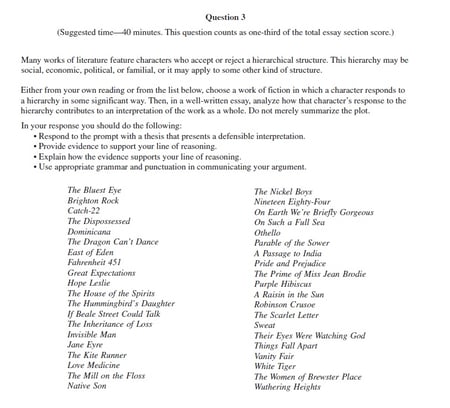
As you can see, the list of works provided spans many time periods and countries : there are ancient Greek plays ( Antigone ), modern literary works (such as Margaret Atwood's The Handmaid's Tale ), Shakespeare plays ( The Tempest ), 19th-century English plays ( The Importance of Being Earnest ), etc. So you have a lot to work with!
Also note that you can choose a work of "comparable literary merit." That means you can select a work not on this list as long as it's as difficult and meaningful as the example titles you've been given. So for example, Jane Eyre or East of Eden would be great choices, but Twilight or The Hunger Games would not.
Our advice? If you're not sure what a work of "comparable literary merit" is, stick to the titles on the provided list .

You might even see something by this guy.
How Is the AP Literature Test Graded?
The multiple-choice section of the exam comprises 45% of your total exam score; the three essays, or free-response section, comprise the other 55%. Each essay, then, is worth about 18% of your grade.
As on other AP exams, your raw score will be converted to a score from 1-5 . You don't have to get every point possible to get a 5 by any means. In 2022, 16.9% of students received 5s on the AP English Literature test, the 14th highest 5 score out of the 38 different AP exams.
So, how do you calculate your raw scores?
Multiple-Choice Scoring
For the multiple-choice section, you receive 1 point for each question you answer correctly . There's no guessing penalty, so you should answer every question—but guess only after you're able to eliminate any answer you know is wrong to up your chances of choosing the right one.
Free-Response Scoring
Scoring for multiple choice is pretty straightforward; however, essay scoring is a little more complicated.
Each of your essays will receive a score from 0 to 6 based on the College Board rubric , which also includes question-specific rubrics. All the rubrics are very similar, with only minor differences between them.
Each essay rubric has three elements you'll be graded on:
- Thesis (0-1 points)
- Evidence and Commentary (0-4 points)
- Sophistication (0-1 points)
We'll be looking at the current rubric for the AP Lit exam , which was released in September 2019, and what every score means for each of the three elements above:
To get a high-scoring essay in the 5-6 point range, you'll need to not only come up with an original and intriguing argument that you thoroughly support with textual evidence, but you’ll also need to stay focused, organized, and clear. And all in just 40 minutes per essay!
If getting a high score on this section sounds like a tall order, that's because it is.

Practice makes perfect!
Skill-Building for Success on the AP Literature Exam
There are several things you can do to hone your skills and best prepare for the AP Lit exam.
Read Some Books, Maybe More Than Once
One of the most important steps you can take to prepare for the AP Literature and Composition exam is to read a lot and read well . You'll be reading a wide variety of notable literary works in your AP English Literature course, but additional reading will help you further develop your analytical reading skills .
I suggest checking out this list of notable authors in the 2014 AP Lit Course Description (pages 10-11).
In addition to reading broadly, you'll want to become especially familiar with the details of four to five books with different themes so you'll be prepared to write a strong student-choice essay. You should know the plot, themes, characters, and structural details of these books inside and out.
See my AP English Literature Reading List for more guidance.
Read (and Interpret) Poetry
One thing students might not do very much on their own time but that will help a lot with AP Lit exam prep is to read poetry. Try to read poems from a lot of eras and authors to get familiar with the language.
We know that poetry can be intimidating. That's why we've put together a bunch of guides to help you crack the poetry code (so to speak). You can learn more about poetic devices —like imagery and i ambic pentameter —in our comprehensive guide. Then you can see those analytical skills in action in our expert analysis of " Do not go gentle into that good night " by Dylan Thomas.
When you think you have a grip on basic comprehension, you can then move on to close reading (see below).
Hone Your Close Reading and Analysis Skills
Your AP class will likely focus heavily on close reading and analysis of prose and poetry, but extra practice won't hurt you. Close reading is the ability to identify which techniques the author is using and why. You'll need to be able to do this both to gather evidence for original arguments on the free-response questions and to answer analytical multiple-choice questions.
Here are some helpful close reading resources for prose :
- University of Wisconsin-Madison Writing Center's guide to close reading
- Harvard College Writing Center's close reading guide
- Purdue OWL's article on steering clear of close reading "pitfalls"
And here are some for poetry :
- University of Wisconsin-Madison's poetry-reading guide
- This guide to reading poetry at Poets.org (complete with two poetry close readings)
- Our own expert analyses of famous poems, such as " Ozymandias ", and the 10 famous sonnets you should know
Learn Literary and Poetic Devices
You'll want to be familiar with literary terms so that any test questions that ask about them will make sense to you. Again, you'll probably learn most of these in class, but it doesn't hurt to brush up on them.
Here are some comprehensive lists of literary terms with definitions :
- The 31 Literary Devices You Must Know
- The 20 Poetic Devices You Must Know
- The 9 Literary Elements You'll Find In Every Story
- What Is Imagery?
- Understanding Assonance
- What Is Iambic Pentameter in Poetry?
- Simile vs Metaphor: The 1 Big Difference
- 10 Personification Examples in Poetry, Literature, and More
Practice Writing Essays
The majority of your grade on the AP English Lit exam comes from essays, so it's critical that you practice your timed essay-writing skills . You of course should use the College Board's released free-response questions to practice writing complete timed essays of each type, but you can also practice quickly outlining thorough essays that are well supported with textual evidence.
Take Practice Tests
Taking practice tests is a great way to prepare for the exam. It will help you get familiar with the exam format and overall experience . You can get sample questions from the Course and Exam Description , the College Board website , and our guide to AP English Lit practice test resources .
Be aware that the released exams don't have complete slates of free-response questions, so you might need to supplement these with released free-response questions .
Since there are three complete released exams, you can take one toward the beginning of your prep time to get familiar with the exam and set a benchmark, and one toward the end to make sure the experience is fresh in your mind and to check your progress.

Don't wander like a lonely cloud through your AP Lit prep.
AP Literature: 6 Critical Test-Day Tips
Before we wrap up, here are my six top tips for AP Lit test day:
- #1: On the multiple-choice section, it's to your advantage to answer every question. If you eliminate all the answers you know are wrong before guessing, you'll raise your chances of guessing the correct one.
- #2: Don't rely on your memory of the passage when answering multiple-choice questions (or when writing essays, for that matter). Look back at the passage!
- #3: Interact with the text : circle, mark, underline, make notes—whatever floats your boat. This will help you retain information and actively engage with the passage.
- #4: This was mentioned above, but it's critical that you know four to five books well for the student-choice essay . You'll want to know all the characters, the plot, the themes, and any major devices or motifs the author uses throughout.
- #5: Be sure to plan out your essays! Organization and focus are critical for high-scoring AP Literature essays. An outline will take you a few minutes, but it will help your writing process go much faster.
- #6: Manage your time on essays closely. One strategy is to start with the essay you think will be the easiest to write. This way you'll be able to get through it while thinking about the other two essays.

And don't forget to eat breakfast! Apron optional.
AP Literature Exam: Key Takeaways
The AP Literature exam is a three-hour test that includes an hour-long multiple-choice section based on five prose and poetry passages and with 55 questions, and a two-hour free-response section with three essays : one analyzing a poetry passage, one analyzing a prose passage, and one analyzing a work chosen by you, the student.
The multiple-choice section is worth 45% of your total score , and the free-response section is worth 55% . The three essays are each scored on a rubric of 0-6, and raw scores are converted to a final scaled score from 1 to 5.
Here are some things you can do to prepare for the exam:
- Read books and be particularly familiar with four to five works for the student-choice essays
- Read poetry
- Work on your close reading and analysis skills
- Learn common literary devices
- Practice writing essays
- Take practice tests!
On test day, be sure to really look closely at all the passages and really interact with them by marking the text in a way that makes sense to you. This will help on both multiple-choice questions and the free-response essays. You should also outline your essays before you write them.
With all this in mind, you're well on your way to AP Lit success!
What's Next?
If you're taking other AP exams this year, you might be interested in our other AP resources: from the Ultimate Guide to the US History Exam , to the Ultimate AP Chemistry Study Guide , to the Best AP Psychology Study Guide , we have tons of articles on AP courses and exams for you !
Looking for practice exams? Here are some tips on how to find the best AP practice tests . We've also got comprehensive lists of practice tests for AP Psychology , AP Biology , AP Chemistry , and AP US History .
Deciding which APs to take? Take a look through the complete list of AP courses and tests , read our analysis of which AP classes are the hardest and easiest , and learn how many AP classes you should take .

Want to build the best possible college application?
We can help. PrepScholar Admissions is the world's best admissions consulting service. We combine world-class admissions counselors with our data-driven, proprietary admissions strategies . We've overseen thousands of students get into their top choice schools , from state colleges to the Ivy League.
We know what kinds of students colleges want to admit. We want to get you admitted to your dream schools .
Learn more about PrepScholar Admissions to maximize your chance of getting in.

Ellen has extensive education mentorship experience and is deeply committed to helping students succeed in all areas of life. She received a BA from Harvard in Folklore and Mythology and is currently pursuing graduate studies at Columbia University.
Student and Parent Forum
Our new student and parent forum, at ExpertHub.PrepScholar.com , allow you to interact with your peers and the PrepScholar staff. See how other students and parents are navigating high school, college, and the college admissions process. Ask questions; get answers.

Ask a Question Below
Have any questions about this article or other topics? Ask below and we'll reply!
Improve With Our Famous Guides
- For All Students
The 5 Strategies You Must Be Using to Improve 160+ SAT Points
How to Get a Perfect 1600, by a Perfect Scorer
Series: How to Get 800 on Each SAT Section:
Score 800 on SAT Math
Score 800 on SAT Reading
Score 800 on SAT Writing
Series: How to Get to 600 on Each SAT Section:
Score 600 on SAT Math
Score 600 on SAT Reading
Score 600 on SAT Writing
Free Complete Official SAT Practice Tests
What SAT Target Score Should You Be Aiming For?
15 Strategies to Improve Your SAT Essay
The 5 Strategies You Must Be Using to Improve 4+ ACT Points
How to Get a Perfect 36 ACT, by a Perfect Scorer
Series: How to Get 36 on Each ACT Section:
36 on ACT English
36 on ACT Math
36 on ACT Reading
36 on ACT Science
Series: How to Get to 24 on Each ACT Section:
24 on ACT English
24 on ACT Math
24 on ACT Reading
24 on ACT Science
What ACT target score should you be aiming for?
ACT Vocabulary You Must Know
ACT Writing: 15 Tips to Raise Your Essay Score
How to Get Into Harvard and the Ivy League
How to Get a Perfect 4.0 GPA
How to Write an Amazing College Essay
What Exactly Are Colleges Looking For?
Is the ACT easier than the SAT? A Comprehensive Guide
Should you retake your SAT or ACT?
When should you take the SAT or ACT?
Stay Informed
Get the latest articles and test prep tips!
Looking for Graduate School Test Prep?
Check out our top-rated graduate blogs here:
GRE Online Prep Blog
GMAT Online Prep Blog
TOEFL Online Prep Blog
Holly R. "I am absolutely overjoyed and cannot thank you enough for helping me!”

IMAGES
VIDEO
COMMENTS
Question 2. (Suggested time—40 minutes. This question counts as one-third of the total essay section score.) In the passage below, from The Adventures of Peregrine Pickle (1751) by Tobias Smollett, Mr. Pickle encounters Godfrey Gauntlet, the brother of his beloved Emilia.
Download free-response questions from past exams along with scoring guidelines, sample responses from exam takers, and scoring distributions. If you are using assistive technology and need help accessing these PDFs in another format, contact Services for Students with Disabilities at 212-713-8333 or by email at [email protected].
2017 AP English Literature and Composition Sample Student Responses and Scoring Commentary ... 2−1 Although these essays make some attempt to respond to the prompt, they compound the weaknesses of the papers in the 4−3 range. Often, they are unacceptably brief or incoherent in presenting ... AP® ENGLISH LITERATURE AND COMPOSITION 2017 ...
2-1 These essays compound the weaknesses of the papers in the 4-3 range. Although some attempt has been made to respond to the prompt, the writer's assertions are presented with little clarity, organization, or support from the poem. These essays may contain serious errors in grammar and mechanics. They may offer a complete misreading
2017 AP® ENGLISH LITERATURE AND COMPOSITION FREE-RESPONSE QUESTIONS Question 3 (Suggested time-40 minutes. This question counts as one-third of the total essay section score.) Select a novel, play, or epic poem that features a character whose origins are unusual or mysterious. Then write an essay in which you
Question 2: Tobias Smollett, The Adventures of Peregrine Pickle. The score should reflect the quality of the essay as a whole — its content, style, and mechanics. Reward the students for what they do well. The score for an exceptionally well-written essay may be raised by 1 point above the otherwise appropriate score.
The writing often demonstrates a lack of control over the conventions of composition: inadequate development of ideas, accumulation of errors, or a focus that is unclear, inconsistent, or repetitive. Essays scored a 3 may contain significant misreading and/or demonstrate inept writing. 2−1 These essays compound the weaknesses of the papers in ...
MsEffie's List of Open-ended Questionsfor Advanced Placement® English Literature Exams, 1970-2023. Do not merely summarize the plot. Avoid plot summary. 2023, Set 1. In many works of literature, characters choose to reinvent themselves for significant reasons. They may wish to separate from a previous identity, gain access to a different ...
The 2017 AP® English Literature Free Response Questions focus on varying themes and are each structured differently. Here we discuss the third FRQ prompt which allows you to choose a particular work of literature as the focus of your essay. Portrait of Jane Eyre by Girolamo Pieri Nerli. Jane Eyre by Charlotte Brontë is a well-known classic novel.
The 2017 AP® English Literature Free Response Questions focus on varying themes and are each structured differently. Here we discuss the third FRQ prompt which allows you to choose a particular work of literature as the focus of your essay. ... The following are the main themes which you may discuss in your Great Expectations AP® English Lit ...
This is the best AP Lit practice test available. It's the most recent exam released by the College Board, and it follows the format of the current test with 55 multiple-choice questions and three free-response questions. Definitely make use of this test! 1999 AP English Literature and Composition Exam. This test excludes the poetry and prose ...
55 questions 45% of Score. There are 5 sets of questions made up of 8-13 questions each. Questions include excerpts from prose fiction, drama, or poetry. Each excerpt is accompanied by several multiple-choice questions. There will be at least 2 prose fiction passages (this may include drama) and at least 2 poetry passages.
Question 1. Suggested reading and writing time—55 minutes. It is suggested that you spend 15 minutes reading the question, analyzing and evaluating the sources, and 40 minutes writing your response. Note: You may begin writing your response before the reading period is over.
Prompt: In Ai's poem "The Man with the Saxophone," published in 1985, the speaker encounters a man playing a saxophone. Read the poem carefully. Then, in a well-written essay, analyze how Ai uses literary elements and techniques to convey the complexity of the speaker's encounter with the saxophone player at that particular time and place.
Study with Quizlet and memorize flashcards containing terms like More likely than other types of writing to include words not chosen, not only because they communicate the writer's ideas, but also because they are memorable., when you ____ a literary work, you explore its posible meanings attitudes of the writer., be ______. Answer the prompt with creativity! Everyone else is likely answering ...
The following is a list of our favorite free rhetorical analysis resources for the AP Lang classroom: Stacie Kaminski: A Deep Dive into Rhetorical Analysis. The Garden of English: How to Write a Rhetorical Analysis Essay from Beginning to End. Angie Kratzer: Rhetorical Analysis. Christy's Classroom: Rhetorical Analysis Portfolio.
1 − Essays earning a score of 1 meet the criteria for the score of 2 but are undeveloped, especially simplistic in their explanation, or weak in their control of language. 0 - Indicates an off-topic response, one that merely repeats the prompt, an entirely crossed-out response, a drawing, or a response in a language other than English.
Flashcard Terms Test. This is a great set of AP English Literature flashcards from Quizlet which covers 235 key vocabulary words. Every AP English Literature & Composition practice exam that is available online. Hundreds of challenging questions along with detailed explanations.
1) the relationship Petry establishes between Lutie Johnson and the setting, 2) which figurative language devices Petry employed to establish the relationship, and. 3) any complexity you identified in that relationship. Start a new paragraph that analyzes one pattern of figurative language and its role in the relationship.
The AP English Literature and Composition Exam has consistent question types, weighting, and scoring guidelines every year, so you and your students know what to expect on exam day. There will also be a consistent range of difficulty in the reading passages across all versions of the exam from year to year. The free-response questions will be ...
Download free-response questions from past exams along with scoring guidelines, sample responses from exam takers, and scoring distributions. If you are using assistive technology and need help accessing these PDFs in another format, contact Services for Students with Disabilities at 212-713-8333 or by email at [email protected]. Note ...
The AP Literature Exam is a three-hour exam that contains two sections in this order: An hour-long, 55-question multiple-choice section. A two-hour, three-question free-response section. The exam tests your ability to analyze works and excerpts of literature and cogently communicate that analysis in essay form.
AP ® English Literature and Composition Sample Student Responses ... While the first two free-response questions build on a supplied text, this question includes both the opportunity and the challenge for students to choose a work to discuss. The framework for that choice was